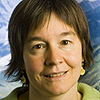That global air and ocean temperatures are rising, and that human activity is largely to blame, is no longer a subject of debate among the vast majority of the world’s climate scientists. But there is no such consensus when talk turns to another important question: Is climate change already causing more extreme weather events, including worsening downpours and flooding, intensifying heat waves, and more powerful hurricanes?
Yale Environment 360 asked eight leading climate experts whether they think there is growing evidence that human-caused global warming is contributing to an increased incidence of extreme weather — and to cite specific recent examples in their answers. Their responses varied, with some contending that rising temperatures already are creating more tempestuous weather and others saying that more extreme weather may be likely but that not enough data yet exists to discern a trend in that direction. Scientists in both camps said two physical phenomena — warmer air holds more moisture, and higher temperatures exacerbate naturally occurring heat waves — would almost by definition mean more extremes. But some argued that the growing human toll from hurricanes, tornadoes, floods, and heat waves is primarily related to burgeoning human population and the related degradation of the environment.

Kevin Trenberth, senior scientist at the U.S. National Center for Atmospheric Research’s Climate Analysis Section.
Yes, undoubtedly. The environment in which all storms form has changed owing to human activities. Global warming has increased temperatures and directly related to that is an increase in the water-holding of the atmosphere. Over the ocean, where there are no water limitations, observations confirm that the amount of water vapor in the atmosphere has increased by about 4 percent, consistent with a 1 degree F warming of sea surface temperatures since about the 1970s. The human component does not change much from year to year and affects all storms.
In the absence of water, during a drought, the extra heat goes into raising temperatures and creating a more intense drought and heat waves, no doubt contributing to the 2010 Russian heat wave. However, the most spectacular events over the past year have been extreme heavy rains: flooding in India, China, and Pakistan in July and August, and then Queensland, Australia in December 2010 and January 2011. Further, very heavy rains in the U.S. in April 2011, along with snow melt, have also led to extensive flooding. In all these cases, very high sea surface temperatures have undoubtedly contributed to extra moisture flowing into the storms that produced the heavy rains and likely contributed to the strength of the storms through added energy. While perhaps a major part of these high sea surface temperatures was related to natural variability such as ENSO [El Nino Southern Oscillation], a component is related to global warming. It is when global warming and natural variability come together that records are broken. Our current work is documenting the link between the Asian flooding and the Russian heat wave and why the blocking anticyclone that led to it was so persistent.

Andrew Watson, professor of environmental sciences at the University of East Anglia.
My answer to this question as posed is no. However, if you were to ask instead whether I expect that human-caused climate change will lead to more extreme weather events, the answer would be yes.
“Human-caused climate change” is something that will develop over decades to a century (the time scale on which greenhouse gas concentrations are changing), and evidence for or against it needs also to be considered over such lengths of time. So if you are thinking about recent events such as Hurricane Katrina, tornadoes in Alabama or Missouri, flooding in Bangladesh, Southeast Asia or on the Mississippi, my answer is that a few such examples of extreme weather cannot, by definition, be used as evidence for, or against, climate change.
Only by long-term statistics can we demonstrate a change that might be attributable to climate. Therefore your request that we give “an example or two of recent extreme weather events that you think either affirm, or refute, the contention that anthropogenic global warming is increasing the frequency and intensity of extreme events” makes no sense to me.
But having said that, I do expect that global warming should lead to more extreme weather events. Extreme weather is powered by large fluxes of energy, much of which comes from latent heat, that is to say from condensation of water vapor. Since a warmer atmosphere will contain more water vapor, I think it makes sense that we should expect more violent weather events in a warmer world. This is a very general prediction however, and certainly not one that any particular extreme event can prove or disprove. Overall I’m prepared to bet that it’s right, but it will take another couple of decades of research and statistics to be sure.

Roger A. Pielke Jr., professor of environmental studies at the University of Colorado.
The IPCC [Intergovernmental Panel on Climate Change] defines “climate change” as a change in the statistics of weather occurring over 30 years or longer and persisting for decades. Thus, the detection of a change in climate requires long-term records. To suggest that particular extreme weather events are evidence of climate change is not just wrong, but wrongheaded — every bit as much as the claims made during a particularly cold and snowy winter (or even several in a row) that such events somehow disprove climate change. Weather is not climate and short-term climate variability is not climate change.
The detection of changes in climate requires looking at actual data — and the data on tornadoes, large-scale river floods (in unaltered river basins), and landfalling hurricanes shows no evidence of trends in the direction of more extreme events. This should not be surprising, because even if we assume a strong signal in extreme events from human-caused climate change, the statistics suggest that it would take many decades, and probably longer, before such signals would be detected.
Given this context, claims that particular events can be attributed in a causal fashion to human emissions of greenhouse gases are simply unscientific if not fundamentally incoherent. It is true that overall damage from tornadoes, floods, and hurricanes has been increasing in recent decades. A recent literature review of extreme event impacts around the world found that everywhere that researchers have looked, this increase can be entirely explained by increasing value of property at risk and increasing exposures to these hazards.
Human-caused climate change is real and deserves effective policies in response. The making of claims that are scientifically unsupportable will not further that effort.

Kerry Emanuel, director of Massachusetts Institute of Technology’s Program in Atmosphere, Oceans and Climate.
There is some evidence that hydrological events are becoming more extreme. This is not so easy to estimate, because rainfall is often quite local, so a good network of observing stations is required. In the U.S., where we have an excellent precipitation network, several published papers present evidence that rainfall is becoming increasingly concentrated into less frequent but more intense events.
Worldwide, satellite-based observations indicate that the most intense tropical cyclones are becoming more frequent even though the far more plentiful weak storms are occurring somewhat less often. In the North Atlantic region, where we have the best observations of such storms, there is a close correlation between their power and the temperature of the tropical Atlantic in summer. This correlation, which was first pointed out in 2005, has grown stronger since. Evidence is mounting that the tropical Atlantic sea surface temperature has been influenced by sulfate aerosol “global dimming” as well as by greenhouse gas increases, while evidence for a “natural cycle” in ocean temperature and storminess is correspondingly less persuasive.
Although this has been an exceptional year for tornadoes in the U.S., strong variations in reporting such events over time prevent us from deducing any long-term trends. Work is under way to examine trends in objective measures of thunderstorm rotation detected by Doppler radar since about 1988, when such radars were first widely deployed. But so far, there has been little theoretical work on how global warming might influence severe local storms, including tornadoes and hail storms.

Judith Curry, chair of Georgia Institute of Technology’s School of Earth and Atmospheric Sciences.
The substantial interest in attributing extreme weather events to global warming seems rooted in the perceived need for some sort of a disaster to drive public opinion and the political process in the direction of taking action on climate change. However, attempts to attribute individual extreme weather events, or collections of extreme weather events, may be fundamentally ill-posed in the context of the complex climate system, which is characterized by spatiotemporal chaos. There are substantial difficulties and problems associated with attributing changes in the average climate to natural variability versus anthropogenic forcing, which I have argued are oversimplified by the IPCC assessments. Attribution of extreme weather events is further complicated by their dependence on weather regimes and internal multi-decadal oscillations that are simulated poorly by climate models.
I have been completely unconvinced by any of the arguments that I have seen that attributes a single extreme weather event, a cluster of extreme weather events, or statistics of extreme weather events to anthropogenic forcing. Improved analysis of the attribution of extreme weather events requires a substantially improved and longer database of the events. Interpretation of these events in connection with natural climate regimes such as
El Nino is needed to increase our understanding of the role of natural climate variability in determining their frequency and intensity. Improved methods of evaluating climate model simulations of distributions of extreme event intensity and frequency in the context of natural variability is needed before any confidence can be placed in inferences about the impact of anthropogenic influences on extreme weather events.

Laurens Bouwer, climate scientist at Vrije University, Amsterdam.
The IPCC has established that here is an increase in the frequency of some extreme weather types at the global level, including heavy rainfall events, and extreme temperatures. Part of these changes is also a result of increasing atmospheric greenhouse gas concentrations. It is hard — if not impossible — to link individual local events to human-caused climate change. Still, the likelihood of particular types of extreme events occurring may have shifted, and so-called attribution studies can demonstrate this to a certain extent. At the same time, the occurrence of local weather extremes is influenced to a large extent by natural climatic variations that have a much more significant impact on timescales of tens of years.
Even more important is that other processes determine the impact of extreme weather events — principally the way humans modify their environment and often settle in locations where natural hazards occur. These are therefore the only reason that we have been seeing more frequent and widespread weather disaster over the past decades. For example, severe flooding has occurred in Pakistan before, but its growing population made the impacts of last year’s flooding much worse. The 2005 flooding disaster in New Orleans could only occur because the population was not well protected against the surge that the winds of hurricane Katrina caused. At the moment there is no record of weather-related disasters in the scientific literature that can be demonstrated to have been caused by human-made climate change causes. In the near future, we will see more disasters in places where growing populations are not well protected from the weather — but not because of climate change that is happening today and tomorrow.

Gabriele C. Hegerl, professor of climate system science at the University of Edinburgh.
Not all extreme events are expected to increase or even change. For example, there is quite a bit of evidence that greenhouse gas increases have contributed to recent widespread changes in the frequency of extreme temperatures, but this encompasses both decreases in the number of cold days and nights and increases in the number of warm nights. The widespread recent warming, which for global and continental mean data has been found to be likely due largely to human influences, leads to a changing probability of extreme temperatures. However, there are also cases where the tail of the temperature distribution is changing differently from the mean. Warming can lead to more severe drought in regions and seasons where precipitation decreases or remains largely unchanged, while evaporation increases due to warmer temperatures. Furthermore, the warming atmosphere has been shown to become moister. This probably explains the statistically significant shift towards more extreme precipitation events worldwide, which cannot be explained by climate variability and is best explained by human influences.
Individual weather extremes can generally neither confirm nor dispute the role of humans in climate change. The only meaningful approach is to estimate changes in the probability of events of the kind observed, and then see if human influence has changed this probability. For example, there is a very convincing study that shows that the probability of a heat wave of the magnitude of the 2003 European heat wave has very likely substantially increased due to global warming. Recently, another similar study showed that the fall 2000 floods in the UK were more likely in a warming world than they would have been without human influence on climate.

William Hooke, director of the American Meteorological Society’s Policy Program.
We live on a planet that does much if not most of its business through extreme events. What we call “climate” reflects the summing-up of these extremes to find averages. And what we call climate “variability” or “change” will therefore be reflected in variability or change in the locations, timing, patterns, intensity, and duration of these extremes.
That said, the statistics of the extremes are inherently noisy. Teasing out long-term changes in the relationships linking the extremes and the averages merits concerted and sustained scientific attention, but will remain a multi-year aspiration. Scientists — let alone non-experts — will be debating any findings for some time to come. (The most likely place to be convincing earliest may prove to be the statistics for heat waves and cold snaps.)
In the meantime, society has to deal with extremes. The truth is that we’re
not proving very adept at coping with the extremes and hazards we’re facing today. Furthermore, the biggest change in our experience with hazards in coming decades is most likely going to prove to be the result of social change and technology advance: population growth, urbanization, and movements to hazard-prone areas such as coasts; dependence on critical infrastructure; the tendency toward zero-margin societies, in both the developed and developing world; and so on. Land-use and building codes; no-adverse-impact policies for levees and other hazard measures; learning from experience; and public-private collaborations for building community resilience are going to be urgently needed in parallel with the natural science.